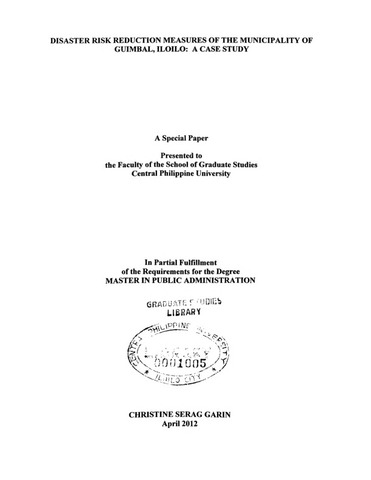Disaster risk reduction measures of the municipality of Guimbal, Iloilo: A case study
Abstract
The paper describes and analyzes the disaster risk reduction measures of the Municipality of Guimbal, Iloilo in order to identify the best practices and the facilitators and the barriers in the implementation of its interventions.
This study utilized the survey method through a focused group discussion in order to collect qualitative data from the members of Guimbal Municipal Disaster Risk Reduction Management Council and the Barangay Disaster Risk Reduction Management Committee. Responses were used in this paper in a descriptive narrative, photo exhibit and tabular presentation using the input, throughput, output approach and the identification of barriers and facilitators.
Guimbal MDRRMC's measures were discussed along the four areas of the National Disaster Coordinating Council framework namely 1) Mitigation, 2) Preparedness, 3) Response, and 4) Rehabilitation.
Mitigation programs of the Guimbal MDRRMC are Environmental Management, Development Plans, Financial Tools, and Risk Assessment, Monitoring.
Vulnerability, Capacity and Analysis. Preparedness programs of Guimbal MDRRMC identified are the Involvement of Various Sectors. Legal Framework. Institutional
Framework, Preparedness and Contingency Plans, Barangay Disaster Risk Reduction Management Committee, Early Warning, Information and Communication, and Knowledge Development thru Education, Training, Drills and Exercises. Guimbal MDRRMC's relief measures are Damage Assessment and Needs Analysis, Evacuation and Relief, Search and Rescue, Disaster Management Office and Center, and Emergency Medical Services. Identified rehabilitation measures are Volunteer Works and Livelihood, Housing, Lifelines and other Assistance, and Infrastructure.
The best practices of Guimbal MDRRMC are the Community Based Disaster Risk Reduction Measures, Massive Information and Education Campaign, Formation of GREAT Responders , Active Involvement of Different Sectors, Memorandum of Agreement with Business and Service Providers, and Relief Assistance Outside its Locality.
Facilitators which assisted in the implementation of Guimbal MDRRMCs implementation of interventions in the four areas of the NDCC framework are 1) Strong Leaders, Active and Supportive Members, 2) Actual Experience of Past Disasters, 3) Strong Community Awareness and Involvement, 4) Knowledge and Training, 5) Information Campaign/ Drills, 6) Joining Competitions, 7) Strong Executive/ Legislative Relationship, 8) Political Network, 9) Linkages Within and Outside the Municipality, 10) Conduct of Competitions of the BDRRMCs, 11) Continuity of Thrusts in Government, 12) Existence of Legal Mandates, 13) Various Infrastructures, 14) Accessibility and Proximity of Barangays To The Town Center, 15) Location of Barangays in Hazard Prone Areas, and 16) Availability of Equipment.
Identified barriers in the implementation of the interventions in the four areas of the framework are 1) Limited Financial Capacity. 2) Intangible Benefits, 3) Limited Equipment. 4) Sense of Apathy. 5) Absence of Site for Housing Project. 6) Limited Number of Volunteer Members, 7) Damaged Infrastructures, 8) Illegal Settlers, 9) Dependent Barangays, 10) Change of MDRRMC Membership, 11) Lenient Implementation of Programs, 12) Yearly Assistance to the Same Families, and 13) Unsafe Roads.
In order to make to programs more effective, Guimbal MDRRMC should formulate a new CLUP, use the Geographic Information System in creating the hazard maps for accuracy and the incorporation of disaster risk reduction in student curriculum.
The social and physical environment in the town of Guimbal paved the way for the successful implementation of the various risk reduction programs. Guimbal MDRRMC should focus on the strength or facilitators that were already inherent in its system and minimize the barriers hampering its success. Guimbal MDRRMC should ask for technical or financial assistance from organizations and foundations to increase financial and technical resources, partner with Gawad Kalinga for housing and livelihood program, plan and build infrastructure that takes into account the increased intensity and strength of hazards in the next 50 years, and set-up of monitoring committee for program implementation.
The study showed that the significant influence of Guimbal. The program's practicality makes it sustainable and can be easily replicated by other municipalities.
Description
Abstract only
Suggested Citation
Garin, C. S. (2012). Disaster risk reduction measures of the municipality of Guimbal, Iloilo: A case study (Unpublished Master's Special paper). Central Philippine University, Jaro, Iloilo City.
Type
Special paperSubject(s)
Keywords
Department
School of Graduate StudiesDegree
Master in Public AdministrationShelf Location
GSL Theses 351.072 G183
Physical Description
xii, 151 leaves
Collections
The following license files are associated with this item:




